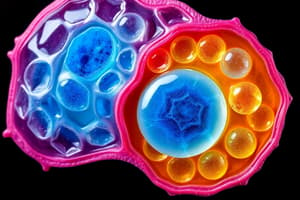Podcast
Questions and Answers
Which of the following is NOT a characteristic of living organisms?
Which of the following is NOT a characteristic of living organisms?
- Exchange materials with surroundings
- Ability to reproduce
- Ability to fly (correct)
- Capable of self-regulation
What distinguishes eukaryotic cells from prokaryotic cells?
What distinguishes eukaryotic cells from prokaryotic cells?
- Presence of peptidoglycan
- Presence of a nucleus (correct)
- Presence of ribosomes
- Lack of DNA
Which scientist is associated with the concept of 'survival of the fittest' in evolution?
Which scientist is associated with the concept of 'survival of the fittest' in evolution?
- Jean Baptiste Lamarck
- Richard Dawkins
- Gregor Mendel
- Charles Darwin (correct)
Which of the following describes a major difference between mitosis and meiosis?
Which of the following describes a major difference between mitosis and meiosis?
What is the primary role of ribosomes within a cell?
What is the primary role of ribosomes within a cell?
Study Notes
Introduction to Biological Concepts
- Evolution explains the development of living organisms from earlier forms, emphasizing changes across generations.
- Jean Baptiste Lamarck proposed spontaneous generation of species based on needs and functionality.
- Charles Darwin introduced the concept of "survival of the fittest" tied to mutations affecting species adaptation.
Cell Theory
- Living organisms are complex systems defined by physicochemical materials capable of self-regulation, metabolism, and reproduction.
- Key characteristics of organisms include:
- Composed of cells as the basic unit of life.
- Require energy for survival and growth.
- Ability to reproduce and maintain homeostasis.
- Organized structure that can respond to environmental stimuli.
- Capable of growing, developing, and exchanging materials with surroundings (water, wastes, gases).
Cell Characteristics
- Cells are the smallest units of life, containing structures that facilitate transport, metabolism, respiration, and reproduction.
- Reproduction occurs through:
- Mitosis for multiplication.
- Meiosis for generating gametes.
Prokaryotes
- Prokaryotic cells feature a nucleoid region housing DNA, lacking a defined nucleus.
- Encased by a cell membrane and cell wall primarily made of peptidoglycan.
- Ribosomes present in the cytoplasm synthesize proteins without membrane encapsulation.
Eukaryotes
- Eukaryotic cells possess a true nucleus and membrane-bound organelles.
- Includes diverse groups: protists, fungi, plants, and animals.
- Represents more complex cellular structure compared to prokaryotes.
Studying That Suits You
Use AI to generate personalized quizzes and flashcards to suit your learning preferences.
Description
Test your knowledge on key topics from Unit 1 of Biology, including cell theory, tissue differentiation, and the concept of evolution. This quiz covers essential biological processes and classifications, providing a comprehensive review of cellular functions and genetic principles.




